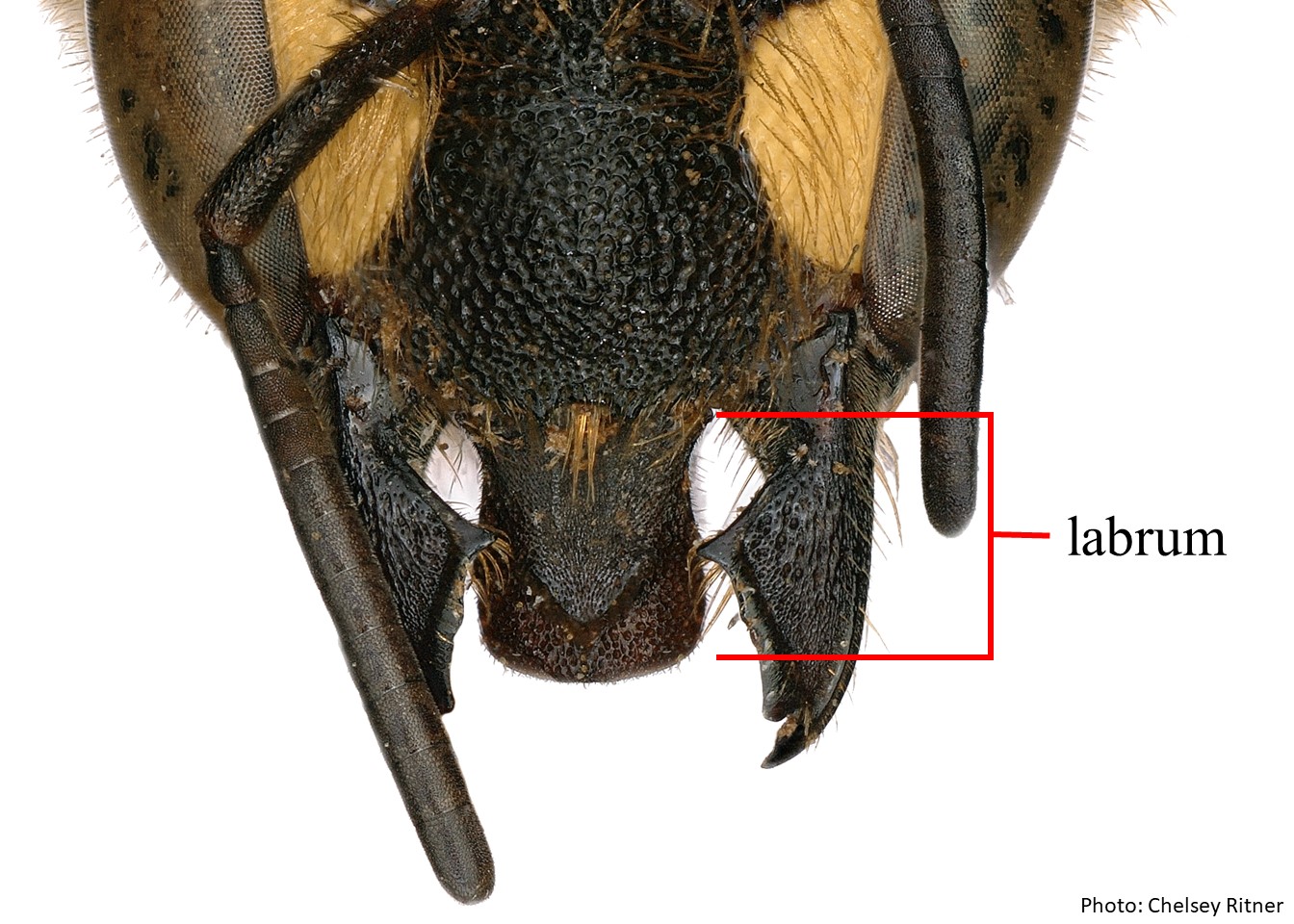Family: Megachilidae
Subfamily: Megachilinae
Tribe: Anthidiini
Genus: Anthidium Fabricius, 1804
Subgenus: A, (Anthidium) Fabricius, 1804
Species: Anthidium rodriguezi Cockerell, 1912
Common name: none
Anthidium (Anthidium) rodriguezi are black except for the dark brown coloration on their antenna and tarsitarsi:
the group of segments at the end of the leg following the tibia
and yellow maculations. Females have white to cream pubescencepubescence:
short, fine hair
with darker hairs on the clypeusclypeus:
a section of the face below the antennae, demarcated by the epistomal sutures, supraclypeal areasupraclypeal area:
the region of the head between the antennal sockets and clypeus, demarcated on the sides by the subantennal sutures, vertexvertex:
the area between the ocelli and the back of the head, scutumscutum:
the large segment on top of the thorax located between the wings and behind the head
discs, coxaecoxae:
the basal segment of the leg, trochanters, inner tarsitarsi:
the group of segments at the end of the leg following the tibia
, and S6S6:
the plates on the underside of the abdomen, often abbreviated when referring to a specific segment to S1, S2, S3, S4, S5, S6, S7, or S8
 (Gonzalez and Griswold 2013Gonzalez and Griswold 2013:
(Gonzalez and Griswold 2013Gonzalez and Griswold 2013:
Gonzalez, V.H. and T.L. Griswold. 2013. Wool carder bees of the genus Anthidium in the Western Hemisphere (Hymenoptera: Megachilidae): diversity, host plant associations, phylogeny, and biogeography. Zoological Journal 168: 221ndash;425.). Females range in body length from 13.1–19.2 mm. Males have short, stout, simple, dark-brown hairs on the ventralventral:
of, on, or relating to the underside of an animal, or segment of an animal
surface of the mesepisternummesepisternum:
the second or middle segment on the side of the thorax bearing the middle legs and the forewings, the pronotum is the first segment
, metepisternummetepisternum:
thorax segment bearing the hind legs and hind wings
, and base of the hind coxacoxa:
the basal segment of the leg. Males range in body length from 16.9–21.5 mm (Gonzalez and Griswold 2013Gonzalez and Griswold 2013:
Gonzalez, V.H. and T.L. Griswold. 2013. Wool carder bees of the genus Anthidium in the Western Hemisphere (Hymenoptera: Megachilidae): diversity, host plant associations, phylogeny, and biogeography. Zoological Journal 168: 221ndash;425.).
(modified from Gonzalez and Griswold 2013Gonzalez and Griswold 2013:
Gonzalez, V.H. and T.L. Griswold. 2013. Wool carder bees of the genus Anthidium in the Western Hemisphere (Hymenoptera: Megachilidae): diversity, host plant associations, phylogeny, and biogeography. Zoological Journal 168: 221ndash;425.)
 has basalbasal:
has basalbasal: has distinct laterallateral:
has distinct laterallateral: preapicalpreapical:
preapicalpreapical: lacks basalbasal:
lacks basalbasal: apicalapical:
apicalapical: apicalapical:
apicalapical: is narrowly projected apicallyapically:
is narrowly projected apicallyapically: is elongate with a weakly bifidbifid:
is elongate with a weakly bifidbifid: laterallateral:
laterallateral: laterallateral:
laterallateral:Anthidium rodriguezi can be differentiated from all Anthidium species in the U.S. except for A. chamelenseby their large body size and entirely or nearly entirely black abdomen. Female A. rodriguezi can be differentiated from A. chamelenseby the T6T6:
the segments on the top side of the abdomen, often abbreviated when referring to a specific segment to T1, T2, T3, T4, T5, T6, or T7 with acutely pointed laterallateral:
with acutely pointed laterallateral:
relating, pertaining, or attached to the side
and sublateral spines. Male A. rodriguezi can be distinguished by their T6T6:
the segments on the top side of the abdomen, often abbreviated when referring to a specific segment to T1, T2, T3, T4, T5, T6, or T7 with laterallateral:
with laterallateral:
relating, pertaining, or attached to the side
spines that are reduced or absent (Gonzalez and Griswold 2013Gonzalez and Griswold 2013:
Gonzalez, V.H. and T.L. Griswold. 2013. Wool carder bees of the genus Anthidium in the Western Hemisphere (Hymenoptera: Megachilidae): diversity, host plant associations, phylogeny, and biogeography. Zoological Journal 168: 221ndash;425.).
Anthidium rodriguezi adults have been recorded in flight from June to early December, with peak activity occurring from October to November (Gonzalez and Griswold 2013Gonzalez and Griswold 2013:
Gonzalez, V.H. and T.L. Griswold. 2013. Wool carder bees of the genus Anthidium in the Western Hemisphere (Hymenoptera: Megachilidae): diversity, host plant associations, phylogeny, and biogeography. Zoological Journal 168: 221ndash;425.).
Anthidium rodriguezi has been observed visiting Bidens sp. (Asteraceae), Salvia leptostachys, and S. melissodora (Lamiaceae) (Gonzalez and Griswold 2013Gonzalez and Griswold 2013:
Gonzalez, V.H. and T.L. Griswold. 2013. Wool carder bees of the genus Anthidium in the Western Hemisphere (Hymenoptera: Megachilidae): diversity, host plant associations, phylogeny, and biogeography. Zoological Journal 168: 221ndash;425.).
Nesting behavior is unknown.
Anthidium rodriguezi are found in Honduras, Guatemala, and Mexico (Gonzalez and Griswold 2013Gonzalez and Griswold 2013:
Gonzalez, V.H. and T.L. Griswold. 2013. Wool carder bees of the genus Anthidium in the Western Hemisphere (Hymenoptera: Megachilidae): diversity, host plant associations, phylogeny, and biogeography. Zoological Journal 168: 221ndash;425.). In Mexico, they occur from Chiapas to Sinaloa, Nuevo Leon, and Tamaulipas. They are primarily found in dry forests, pine-oak forests, and moist forests (Gonzalez and Griswold 2013Gonzalez and Griswold 2013:
Gonzalez, V.H. and T.L. Griswold. 2013. Wool carder bees of the genus Anthidium in the Western Hemisphere (Hymenoptera: Megachilidae): diversity, host plant associations, phylogeny, and biogeography. Zoological Journal 168: 221ndash;425.). None are known to occur in the U.S. or Canada.
Distribution map generated by Discover Life -- click on map for details, credits, and terms of use.
Gonzalez, V.H. and T.L. Griswold. 2013. Wool carder bees of the genus Anthidium in the Western Hemisphere (Hymenoptera: Megachilidae): diversity, host plant associations, phylogeny, and biogeography. Zoological Journal of the Linnean Society 168: 221-425.